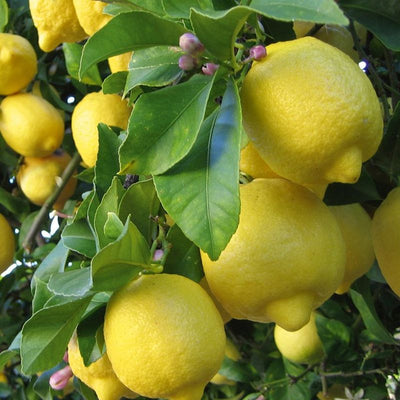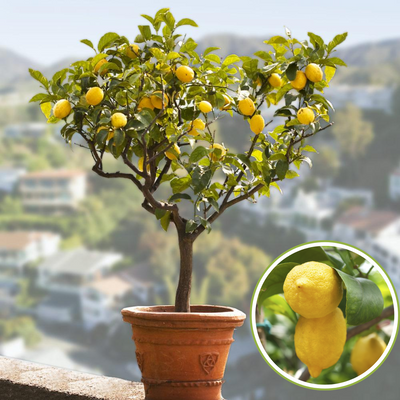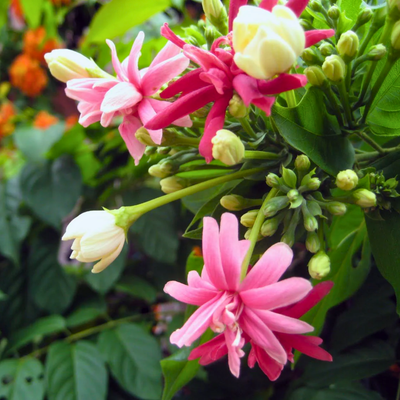



Rare Baobab tree Kalpvriksh choramlo Live Healthy Plant
2 reviews
Rs. 1,399.00
Rs. 940.00
Guaranteed Safe Checkout
The Enigma of The Baobab: Unveiling
the Secrets of a Rare and Magnificent
Tree
About Baobab Tree
In the heart of some of the world's most arid and unforgiving landscapes, a true marvel of nature stands tall – the Baobab tree. Revered by ancient civilizations and sought after by modern-day nature enthusiasts, the Baobab tree, with its distinctive features and awe-inspiring presence, remains a testament to the resilience and beauty of life in the most challenging environments.
A Glimpse into the Extraordinary
- The Baobab tree, scientifically known as Adansonia, holds a special place in the botanical world.
- There are nine species of Baobabs, each with its own unique characteristics.
- The most iconic among them is Adansonia grandidieri, known for its towering presence and stout trunk that often takes on a cylindrical or bottle-like shape.
- This peculiar form has earned it the nickname "upside-down tree," as its leafless branches resemble roots reaching for the sky.
Habitat and Distribution
- One of the most fascinating aspects of the Baobab tree is its ability to thrive in some of the harshest environments on Earth.
- Found predominantly in Africa, Madagascar, and parts of Australia, Baobabs have managed to adapt to regions with scant rainfall and high temperatures.
- Their trunks serve as natural water reservoirs, allowing them to endure months – even years – of drought.
Cultural Significance and Ancient Wisdom
- Beyond its physical attributes, the Baobab tree has deep cultural and historical significance.
- In African folklore, it's often referred to as the "Tree of Life," symbolizing longevity, strength, and sustenance.
- Many communities have used its bark, leaves, and fruits for medicinal purposes, and its hollow trunks have been turned into shelters, storage units, and even places of worship.
Threats to Survival
- Despite its legendary resilience, the Baobab tree faces modern challenges that put its survival at risk.
- Deforestation, habitat loss, and climate change are causing disruptions to its natural habitat and growth patterns.
- Conservation efforts have been initiated to protect these ancient giants and the ecosystems they support.
Unlocking the Baobab's Secrets
- Scientists are delving into the mysteries of the Baobab tree, uncovering its secrets for potential applications in various industries.
- Baobab fruit, rich in vitamin C and antioxidants, has gained popularity as a superfood.
- Its pulp can be transformed into powder and used in food products, while the oil extracted from its seeds shows promise in cosmetics and medicinal applications.
A Call for Preservation
- Preserving the Baobab tree goes beyond safeguarding a botanical wonder; it's about protecting the delicate balance of ecosystems that depend on its presence.
- Collaborative efforts among governments, conservation organizations, and local communities are essential to ensure that these ancient sentinels continue to grace our planet for generations to come.
Growing the Magnificent Baobab Tree: Unveiling the
Secrets to Cultivating a Rare Wonder
The Baobab tree, scientifically known as Adansonia, is an ancient and rare wonder of the botanical world. With its iconic swollen trunk and picturesque branches, it's often referred to as the "Tree of Life." While typically found in the arid regions of Africa, Australia, and the Middle East, cultivating a Baobab tree in your own garden can be a rewarding and unique horticultural journey. In this guide, we will delve into the fascinating world of Baobab tree cultivation, uncovering the secrets to successfully growing this majestic botanical rarity.
Understanding the Baobab Tree
- The Baobab tree's distinctive appearance sets it apart from other trees. Its stout trunk, which can store water, allows it to thrive in some of the most unforgiving environments.
- The Baobab's large, pendulous white flowers, along with its peculiar, hanging fruit, add to its enchanting beauty.
Choosing the Right Location
- Selecting the appropriate location is crucial for the Baobab tree's growth.
- It thrives in full sunlight, so choose a spot in your garden that receives ample sunlight throughout the day.
- The tree's size can vary, so be mindful of its potential height and spread as it matures.
- A well-draining soil is essential to prevent waterlogging, as the Baobab tree is sensitive to excessive moisture.
Starting from Seeds
- Growing a Baobab tree from seeds is a patient yet rewarding process.
- Obtain fresh seeds from a reputable source.
- To enhance germination, it's advisable to soak the seeds in water for a day or two.
- Plant the seeds in a well-draining potting mix and keep them in a warm, sunny location.
- It's important to note that Baobab seeds have a hard coating, so gently sanding the edges or making a small nick can aid in germination.
Caring for Young Baobab Trees
- As the seedlings emerge, provide them with ample sunlight and maintain consistent moisture in the soil.
- However, avoid overwatering, as the Baobab tree is adapted to arid conditions.
- Once the seedlings develop a few leaves, you can gradually reduce watering frequency.
Transplanting into the Ground
- Before transplanting your young Baobab tree into the ground, ensure the soil is well-draining and amend it with organic matter.
- Transplant during the warmer months to give the tree the best chance to establish its root system.
- Water the newly transplanted tree regularly, especially during its initial growth period.
Patience is Key
- Growing a Baobab tree demands patience.
- These trees are known to have slow growth rates, and it might take several years for them to reach notable heights.
- Regular, moderate fertilization can aid in their growth, but avoid excessive fertilizers, as they can harm the tree's delicate root system.
Protection from Frost and Cold
- If you reside in a region with cold winters, protecting your Baobab tree from frost is essential.
- These trees are highly susceptible to cold temperatures, which can damage or even kill them.
- Consider covering the tree with a frost cloth or bringing it indoors during the coldest months.
Embracing the Marvel of the Baobab
- Cultivating a Baobab tree is not merely an act of gardening; it's an investment in an ancient marvel, a connection to nature's resilience.
- As you care for your Baobab tree and witness its gradual growth, you become part of a legacy that spans centuries.
- Remember, the key lies in understanding its unique requirements, being patient, and giving it the love and attention it deserves.
- With time, your garden can proudly boast the presence of a rare and awe-inspiring Baobab tree.
K
Kiran Singh Ordered the Baobab Plant and was amazed by the packaging and plant health. Highly recommended
a
anu received a nice plant . thankyou green paradise
𝗥𝗲𝗹𝗮𝘁𝗲𝗱 𝗽𝗿𝗼𝗱𝘂𝗰𝘁𝘀
Flowering Plants
Green Paradise Tabebuia rosea Pink Trumpet Tree
Green Paradise Offers Beautiful Tabebuia Rosea Pink Trumpet Tree About Tabebuia Rosea Pink Trumpet Tree Green Paradise Presents Beautiful Pink Flowered Tree Tabebuia Rosea. Easy Growing And Can be Grown...
Rs. 699.00
Rs. 449.00
Outdoor Plant
Green Paradise Dwarf Variety Green Coconut Plant
Green Paradise Offers Dwarf Variety Green Coconut Plant About Green Coconut Plant The dwarf variety of green coconut plants, also known as the dwarf coconut palm or Cocos nucifera...
Rs. 699.00
Rs. 499.00
Fruit Plants
Green Paradise Italian Lemon Fruit Live Plant
Green Paradise Offers Amazing And Most Easy To Grow Italian Lemon Plant About The Italian Lemon Plant Light The Lemon Tree thrives in full sun in a place that...
Rs. 399.00
Flowering Plants
Madhumalati Rangoon Creeper Double Petal Plant
Green Paradise Offers Beautiful Madhumalti Double Petal Rangoon Creeper Plant About Madhumalti Creeper The Madhumalti Creeper with Double Petals, also known as Rangoon Creeper (Scientific name: Quisqualis indica), is a...
Rs. 539.00
Rs. 399.00
Fruit Plants
Green Paradise Original Desi Lemon (Kagzi Lemon)Plant
Green Paradise Offers Original & Healthy Desi Lemon Plant About Desi Lemon Plant The Desi Lemon plant, scientifically known as Citrus limon, is a small to medium-sized tree...
Rs. 349.00
Flowering Plants
New rare Blue Hibiscuss Alyogyne huegelii live and healthy plant
Enchanting Elegance: Unveiling the Allure of the Green Paradise Blue Hibiscus Plant About Blue Hibiscus Plant Nature never ceases to amaze us with its boundless creativity, and the blue hibiscus...
Rs. 299.00
SOIL & FERTILIZERS
porous rocks for Soilmix In bonsai,succulents and adenium Plants 5kg pack
green Paradise porous rocks Provides High quality ingredients throughout, Good water-retention, Good drainage and Good aeration to the plants. porous rocks are Light Weight And used as a component of...
Rs. 649.00
Herbal And Medicinal Plants
Maghai Pan Nagarvel Betel Leaf Live Plant
Green Paradise Offers Maghai Pan (Betel Leaf) Plant About Maghai Pan Plant Maghai Paan (Betel leaf), also known as Piper beetle, is a perennial vine belonging to the Piperaceae family....
Rs. 349.00


















